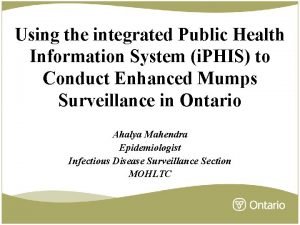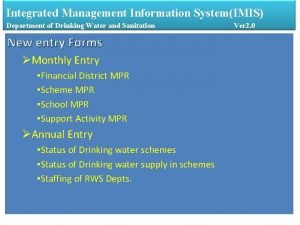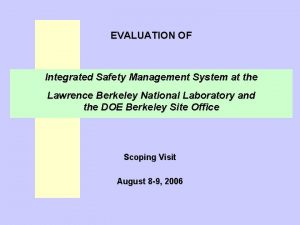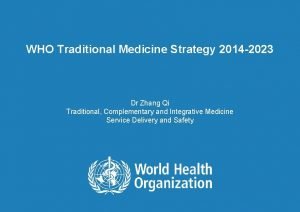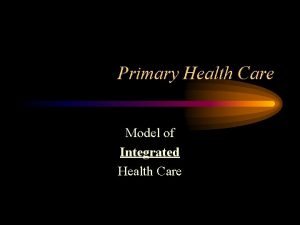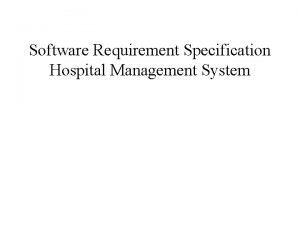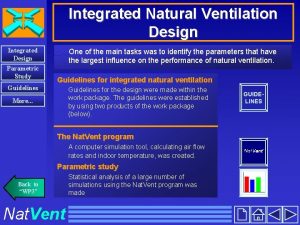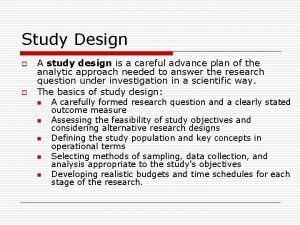Integrated System Health Management Design Study Integrated System



















- Slides: 19

Integrated System Health Management Design Study Integrated System Health Management (ISHM) Design Study The Potential of Designing for/with ISHM Jim Mac. Connell Consensus Technology, LLC 2200 N. 77 th St. Seattle, WA 98104 -4928 Tel: 206. 524. 8555 Fax: 206. 524. 3034 jmac@consensustech. com

Integrated System Health Management Design Study Agenda • Welcome & Introductions 9: 00 • AFRL Overview 9: 10 • ISHM IPT Perspectives Derisso Beachkofski • Study Overview Barthelemy Cruse 10: 00 Navarra 10: 30 Mac. Connell • ISHM Perspectives 11: 00 Participants Lunch 12: 00 • ISHM Perspectives (Cont. ) 12: 30 Participants • Study Discussion 3: 00 Mac. Connell • Wrap Up & Adjourn 4: 00 Barthelemy All

Integrated System Health Management Design Study Agenda • Welcome & Introductions • AFRL Overview 9: 10 9: 00 Barthelemy Cruse • ISHM IPT Perspective 10: 00 Navarra Derisso Beachkofski • Study Overview 10: 30 Mac. Connell • ISHM Perspectives Lunch 11: 00 Participants 12: 00 • ISHM Perspectives (Cont. ) 12: 30 • Study Discussion 3: 00 Mac. Connell • Wrap Up & Adjourn 4: 00 All

Integrated System Health Management Design Study Integrated System Health Management (ISHM) Design Study Overview Jim Mac. Connell Consensus Technology, LLC 2200 N. 77 th St. Seattle, WA 98104 -4928 Tel: 206. 524. 8555 Fax: 206. 524. 3034 jmac@consensustech. com

Integrated System Health Management Design Study Overview • Define and document • The potential impact of an optimized Integrated Health Management System on • Design of Unmanned Air Vehicles (UAVs) • Design of Space Operating Vehicles (SOVs) • The technology issues and shortfalls that would need to be addressed to achieve that impact • Critical technologies that have the potential to address those shortfalls • A business case analysis that provides rationale for: • Designing for/with ISHM • Prioritization of technical shortfalls • Pursuing specific critical technologies • The preferred programmatic approach to pursuing those technologies • Collaborative Approaches (Consortia, Collaborative Programs) • Suite of Conventional CRAD Programs • Challenge is Balance between Program/Initiative building and Technical/Business Assessment

Integrated System Health Management Design Study Schedule Oct Study Development Nov Dec Jan Feb Mar Apr May Initial Industry Meeting • Define conceptual approach • Build collaborative team • Define needs/resources Define Benefits • Ideal System Definition • ISHM <> Design Vision • “Business Case” Dev. Identify Critical Elements • Define technology pieces • Define req’d attributes • Identify short-falls Establish Development Plan • Prioritize technology needs • Develop integration plan • Define resource allocation • Finalize “team” construct Document, Present and Do Initial Study Results (Technology) Final Study Results (Programmatic) Jun

Integrated System Health Management Design Study WBI SOW

Integrated System Health Management Design Study Tasking Task 1: • Study Development 1. define the specifics of the study with the government ISHM IPT, 2. assemble the collaborative ISHM team that will execute the study under the leadership of the Wright Brothers Institute, 3. define the needed effort for Tasks 2 and 3, and 4. identify the government and industry resources required to execute the study. Task 2: • Define the potential impact of an optimized Integrated Health Management System on the design of Unmanned Air Vehicles (UAVs). • Assuming an ideal health management capability, • which would include available sensors with required performance, durability and reliability, the Wright Brothers Institute and the collaborative ISHM team shall: • perform a business case analysis to examine • the monetary trades, system performance, mission availability, and procurement size impact for a new acquisition • if the design accounted for the benefits of health monitoring and management.

Integrated System Health Management Design Study Tasking Task 3: • Define the potential impact of an optimized Integrated Health Management System on the design of Space Operating Vehicles (SOVs). • Assuming an ideal health management capability, • which would include available sensors with required performance, durability and reliability, • perform a business case analysis to examine • the monetary trades, system performance, mission availability, and procurement size impact for a new acquisition • if the design accounted for the benefits of health monitoring and management. Task 4: • Compile and develop a final report that will include • the findings of the study as well as the required R&D to achieve an optimized ISHM. • A summary of the findings quantifying the benefits of the proposed ISHM system and documentation of the business decisions made in selecting the attributes of the ISHM system will be included. • a list of the technical challenges and critical technologies that need to be further developed or desired. • Identification of the required sensors, sensor accuracy and reliability necessary for the OEM to seriously consider its use in an ISHM system. • Definition of any shortfalls in computational, inspection and manufacturing capability which may prohibit the implementation of an ISHM system

Integrated System Health Management Design Study Overall Objectives • To define the overall scope and key research areas of a cross technical directorate effort in ISHM • To define and assess cost, performance, and other benefits that may be achieved by including ISHM capabilities in the conceptual design of aerospace vehicles. • study how ISHM might influence the design of the vehicles and the system as a whole. • quantify the benefits of the “proposed” ISHM system • document the business decisions made in selecting the attributes of the ISHM system • To identify the critical technology elements required to realize those benefits • Define technical challenges and critical technologies that need to be further developed. • Identify the required sensors, sensor accuracy and reliability necessary for the OEM to seriously consider its use in an ISHM system. • Define shortfalls in computational, inspection and manufacturing capability which may prohibit the implementation of an ISHM system will be defined • To establish a roadmap for pursuing those technologies.

Integrated System Health Management Design Study Overall Objective • To define the overall scope and key research areas of a cross technical directorate effort in ISHM • • Focus on collaborative development of: • Technical focus areas • Benefits definition and analysis True INTEGRATION vs. Cross-Functional Development

Integrated System Health Management Design Study Define Benefits • To define and assess cost, performance, and other benefits that may be achieved by including ISHM capabilities in the conceptual design of the vehicles. • • Not just “What are the benefits if the design accounted for the benefits of health monitoring and management. ” Rather “Would we design differently if the ideal ISHM system existed and what would be the benefits of THAT design/system” Opens up the discussion but presents real challenges

Integrated System Health Management Design Study Identify Critical Elements • To identify the critical technology elements required to realize those benefits • Define technical challenges and critical technologies that need to be further developed. • Identify the required sensors, sensor accuracy and reliability necessary for the OEM to seriously consider its use in an ISHM system. • Define shortfalls in computational, inspection and manufacturing capability which may prohibit the implementation of an ISHM system will be defined SOA Vision Real Time Decision Making System Analysis Sensors ? Pattern Recognition Impedance Methods Diagnostics Computational Power Prognostic s Physics Based Approaches System Certification Bandwidth Data Storage

Integrated System Health Management Design Study Establish development plan • To establish a roadmap for pursuing those technologies. • Transform the set of technology needs into a prioritized and structured technology development thrusts Integrate the technology thrusts into a set of discreet, manageable but inter-dependent efforts Define the resources needed for those efforts and the appropriate “team” construct to conduct those efforts successfully • • Real Time Decision Making System Analysis Sensor s ? Diagnostics Pattern Recognition Impedance Methods Computational Power Prognostic s Physics Based Approaches Bandwidth System Certification Data Storage Prognostics System Analysis Pattern Recognition Real Time Decision Making System Certification Diagnostics Prognostics Impedance Methods Physics Based Approaches Diagnostics Sensors Bandwidth Data Storage Computational Power Impedance Methods Physics Based Approach Computational Power System Analysis Pattern Recognition Real Time Decision Making Sensors Bandwidth Data Storage System Certification

Integrated System Health Management Design Study Overview • Define and document • The potential impact of an optimized Integrated Health Management System on • Design of Unmanned Air Vehicles (UAVs) • Design of Space Operating Vehicles (SOVs) • The technology issues and shortfalls that would need to be addressed to achieve that impact • Critical technologies that have the potential to address those shortfalls • A business case analysis that provides rationale for: • Designing for/with ISHM • Prioritization of technical shortfalls • Pursuing specific critical technologies • The preferred programmatic approach to pursuing those technologies • Collaborative Approaches (Consortia, Collaborative Programs) • Suite of Conventional CRAD Programs • Challenge is Balance between Program/Initiative building and Technical/Business Assessment

Integrated System Health Management Design Study Systems Health Management Ultimate Goal Vehicle Usage Data/Learning Algorithms/Neural Nets CAPABILITY: Material Prognosis (A 1) Component Determine Prognosis (A 2) Quantitative Subsystem Prognosis (A 3)Prediction Remaining Useful of Determine Quantitative Life Future Capability System Prognosis (A 4) Remaining Useful Prediction of Determine Quantitative • State awareness (PROGNOSIS) Life Future Capability Remaining Useful Prediction of Determine Quantitative • Fault anal. • State awareness (PROGNOSIS) Life Future Capability Remaining Useful Prediction of • Life • Fault anal. • prediction State awareness (PROGNOSIS) Life Future Capability • Life A • Fault anal. • prediction State awareness (PROGNOSIS) • Life prediction A • Fault anal. • Life prediction A An Capability Ultimately Limited by Existing Design Methodology Dn Autonomic Maintenance & C 1 Logistics Payoff: Reduced O&S Costs • Less Inspection Time • Less Maintenance Time • Faster Turn Around Perform Mission • In situ mission modification • Life extending C 2 controls, etc. Payoff: Improved Readiness/ Mission Capability Improved Safety NEW design philosophy!! C 3

Integrated System Health Management Design Study Questions to be answered • What are the key features of the ideal ISHM capability? • Know everything about everything? • Discrete versus continuum sensing • What it means versus what it is • Know it now not after • Know what to do about it? • Intelligent decision making • Learning systems • What technologies are required to achieve the ideal ISHM capability? • Bandwidth • Processing power • Sensors • Integrated • Where do we start if our goal is the ideal system? • Building block approach?

Integrated System Health Management Design Study Would ISHM Impact the Following? ØCurrent Structural Design Philosophy Structural Design §Reduce FOS? §Lighter Design? ØNew Structural Design Philosophy § Enable Reliability-based (Probabilistic) Design Approach? § Reduce reliance on structural redundancy for fail-safety, reduces weight and cost? ØStructural/Materials Certification Process Full-Scale Structural Fatigue Test §Reduce Certification Time? ØNew Structural Maintenance Procedure §Enable Condition-Based Maintenance? Structural Inspection

Integrated System Health Management Design Study ISHM IPT Roles and Responsibility Action Teams and Team Leads Propulsion B. Beachkofski PR, ML Sub-Systems K. Navarra ML, SN, PR, VA Avionics M. Wicks SN, ML Structures M. Derriso VA, VS, ML Weapons MN, DE, ML System Health M. Derriso VA, VS, IF Controls J. B. Schroeder VA, VS, PR Net Centric Operations and Logistics C. Curtis IF, HE External Database
 Types of health management information system
Types of health management information system Integrated public health information system
Integrated public health information system Vcaa visual communication
Vcaa visual communication Faculty management system project report
Faculty management system project report Integrated educational information management system
Integrated educational information management system Integrated management information system imis
Integrated management information system imis Integrated engineering management system
Integrated engineering management system Doe integrated safety management
Doe integrated safety management Iqms tutorial
Iqms tutorial Www.gifmis.pfm
Www.gifmis.pfm Integrated financial management system
Integrated financial management system Enterprise wide quality integrated management software
Enterprise wide quality integrated management software Ifms integrated financial management system
Ifms integrated financial management system Feasibility study in system analysis and design
Feasibility study in system analysis and design Who traditional medicine strategy: 2014-2023
Who traditional medicine strategy: 2014-2023 Qi integrated health
Qi integrated health District integrated health and family welfare society
District integrated health and family welfare society Integrated primary health care model
Integrated primary health care model Dfd diagram of hospital management system
Dfd diagram of hospital management system Laudon and laudon 2012
Laudon and laudon 2012

